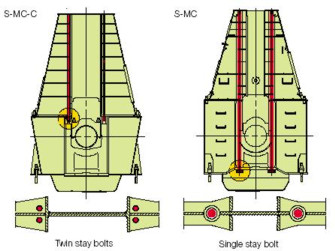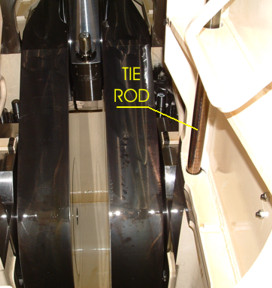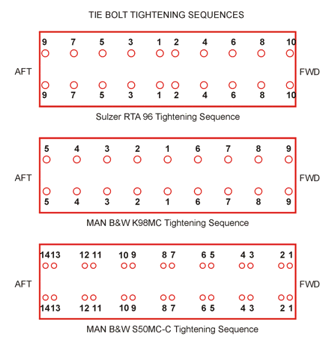To understand the importance of the role played by the tie bolts or tie rods, it is necessary to appreciate what is happening inside the cylinder of the engine. When the piston is just after top dead centre the pressure inside the cylinder can rise as high as 140 bar (14000kN/m2). This acts downwards through the piston rod and con-rod, pushing the crankshaft down into the bearing pockets. At the same time, the pressure acts upwards, trying to lift the cylinder cover. The cylinder head studs screwed into the entablature prevent this happening and so this upward acting force tries to lift the entablature from the frames and the frames from the bedplate, putting the fitted location bolts into tension. As the piston moves down the cylinder the pressure in the cylinder falls, and then rises again as the piston changes direction and moves upwards on the compression stroke. This means that the fitted bolts are under are cyclic stress. Because they are not designed to withstand such stresses they would soon fail with disastrous consequences.
Once fretting between the mating surfaces has occurred, then tightening of the tie bolts will pull the engine out of alignment. The crosshead guides, the cylinder liner, and the stuffing box will no longer be in line and excessive wear will occur. Because the tie bolts will no longer be pulled down squarely they will be subject to forces which may lead to them breaking. If fretting has occurred, then the only solution is to remove the entablature or/and frame and machine the fretted mating surfaces (a very costly exercise).
Tie bolts can break in service. To reduce the risk of this happening they must be checked for tightness; not overtightened; and the engine not overloaded. If a breakage does occur, this is not disastrous, as the engine can be operated with care for a limited period (the load on the engine may have to be reduced). The position of the fracture will dictate how the broken pieces are removed. However in the worst possible scenario where the bolt is broken at mid length, then one solution is to lift out the top half, remove the bottom nut, and then feed a loop of braided wire cable (about 7mm diameter) down the tie bolt tube, down the side of the broken tie bolt and once it emerges at the bottom a supporting piece can be fitted to the wire enabling the broken tie bolt to be withdrawn. Another method is shown here
On the MAN B&W MC-C engine the tie bolts do not pass through the bedplate transverse girder in the traditional way. Instead there are two pairs of tie bolts fitted either side of the single plate A frame and screwed into the bedplate transverse girder. This, it is claimed, reduces the distortion of the bedplate during engine operation.
|





